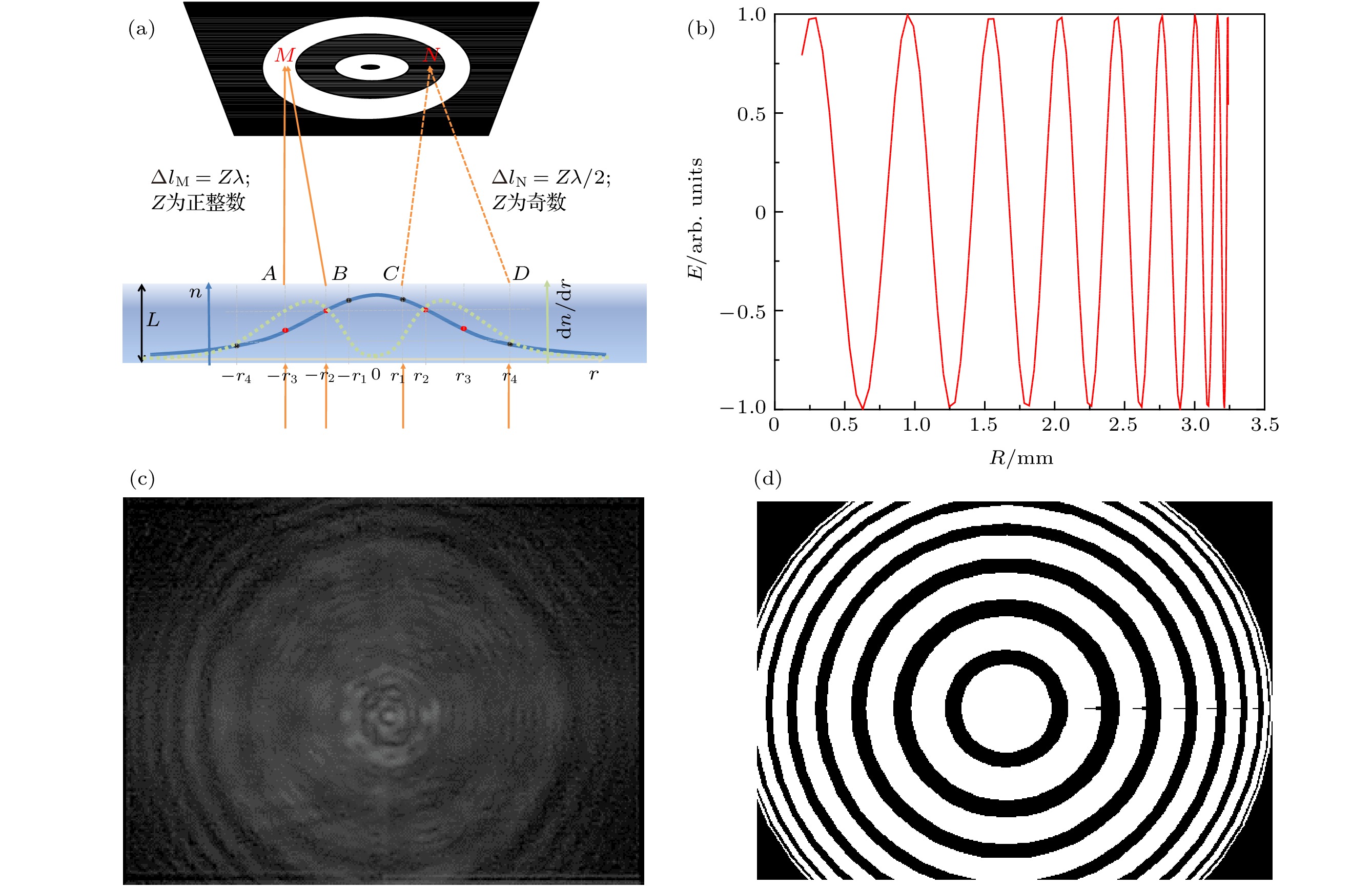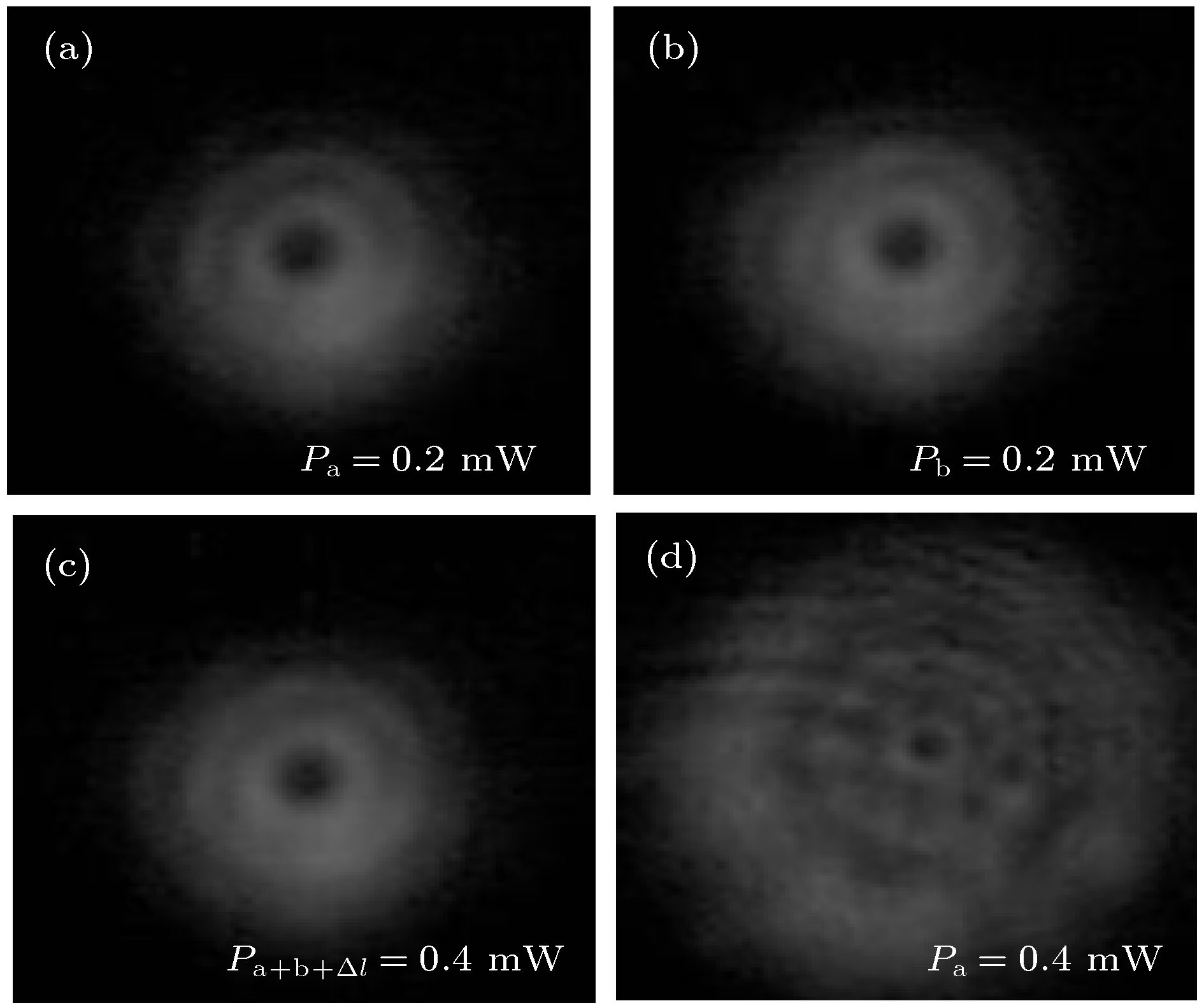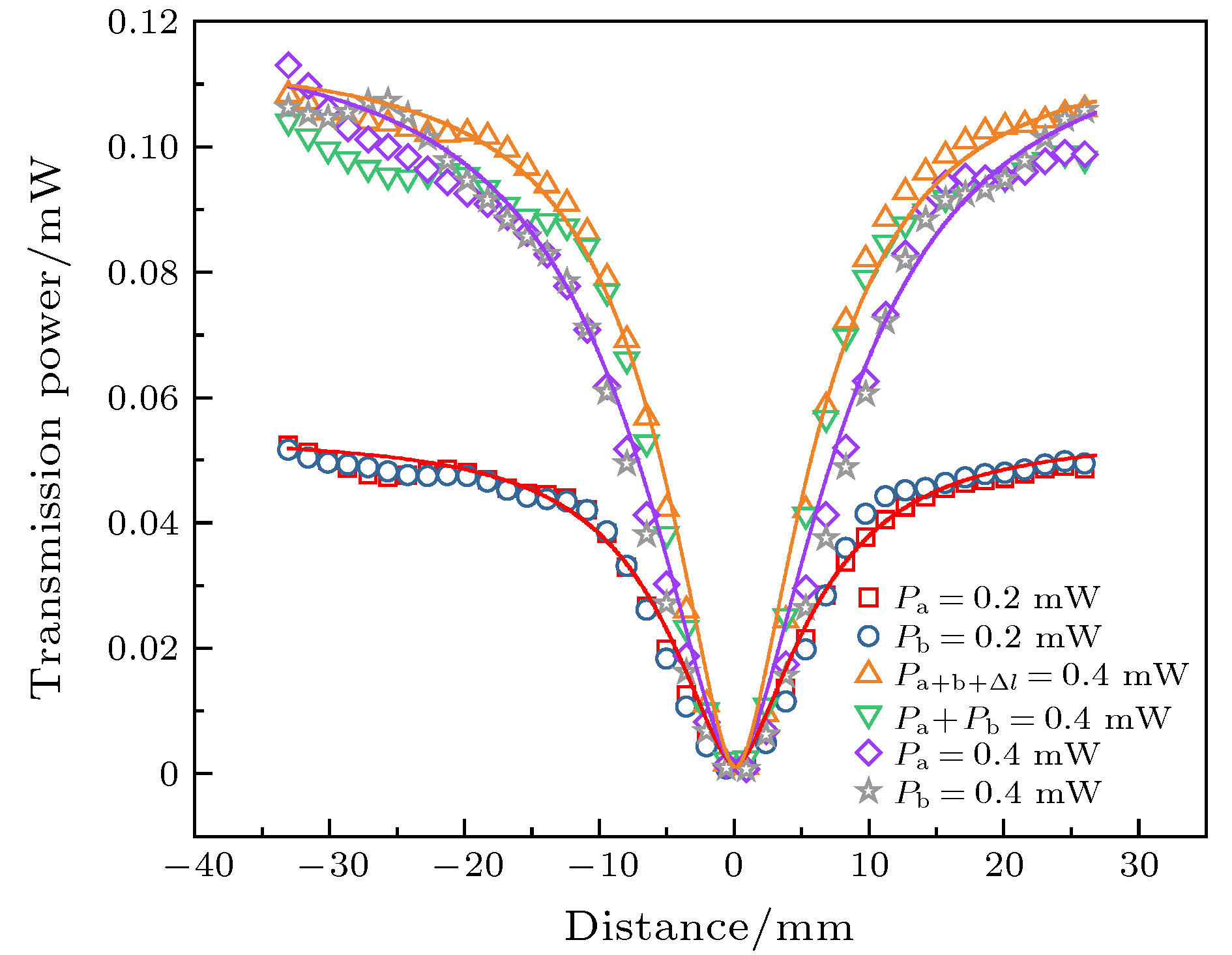-
用飞秒脉冲激光照射砷化镓(gallium arsenide, GaAs)晶体, 透射光出现了多级的干涉环. 利用透射式Z-扫描光路, 改变飞秒脉冲激光入射到GaAs晶体表面时的功率密度, 观察到干涉环有规律地收缩(或扩张): 功率密度越大, 出现的干涉环越多, 张角也越大. 高强度飞秒脉冲激光的非线性效应局部地改变了GaAs晶体的折射率, 从而导致光程差的出现, 这是一种非线性效应(克尔透镜). 超快光脉冲在GaAs晶体里产生的克尔透镜不能像理想的薄透镜那样把光束聚焦, 而是让透镜光束形成了干涉环. 通过分析干涉环的变化, 可以得到GaAs晶体的非线性吸收系数和非线性折射率.Gallium arsenide (GaAs) is an important semiconductor material with direct bandgap and clear-cut absorption edge. High-quality crystal is available, which has excellent performances in the field of high power transmission and luminescence because of high laser damage threshold and high thermal conductivity. Nonlinear optics is of great significance for developing the laser technology, spectroscopy, and optoelectronic devices. The Z-scan technology is a nonlinear measurement method based on the analysis of single beam transmittance. Previous studies mainly focused on the measurement of the nonlinear absorption coefficient of the sample by open-aperture configuration of Z-scan and the nonlinear refractive index of the sample by shut-aperture configuration of Z-scan. We build a dual-channel Z-scan system with variable optical path difference, equipped together with a high speed camera, to observe the spatial distribution of transmitted light. Besides, we find the interference rings induced by nonlinear absorption in semiconductor GaAs crystals. Using three kinds of lasers (continuous-wave laser, 80 MHz femtosecond pulsed laser, 1 kHz femtosecond pulsed laser) to illuminate the GaAs crystal separately, multi-level interference rings come out only when a GaAs crystal wafer is illuminated by a femtosecond pulsed laser. In the single-channel Z-scan experiment, we observe that the interference rings contract or expand regularly when changing pulsed laser intensity incident on the surface of GaAs crystal. The higher the intensity of pulse, the more interference rings appear, and the maximum exiting angle becomes larger. Nonlinear effect of high intensity femtosecond pulsed laser locally changes the refractive index of GaAs crystals, resulting in optical path difference (Kerr lens effect). However, the Kerr lens generated by ultrafast light pulse in GaAs crystal cannot focus a beam as done by an ideal thin lens, leading the transmitted light to form interference rings instead. By analyzing the variation of the interference rings, the nonlinear absorption coefficient and refractive index of GaAs crystal can be obtained. In the dual-channel Z-scan experiment, different interference rings are induced in the GaAs crystal as the path difference between the two pulses changes, as done by the nonlinear transmission power. Thus we obtain the formation time of the interference rings and ascribe it to the ultrafast relaxation process of GaAs carriers.
-
Keywords:
- coherent interference /
- nonlinear optics /
- ultrafast optical pulse /
- Kerr lens
[1] Durbin S D, Arakelian S M, Shen Y R 1981 Opt. Lett. 6 411
 Google Scholar
Google Scholar
[2] Santamato E, Shen Y R 1984 Opt. Lett. 9 564
 Google Scholar
Google Scholar
[3] Pilipetski N F, Sukhov A V, Tabiryan N V, Zeldovich B Y 1981 Opt. Commun. 37 280
 Google Scholar
Google Scholar
[4] He K X, Abeleldayem H, Sekhar P C, Venkateswarlu P, George M C 1991 Opt. Commun. 81 101
 Google Scholar
Google Scholar
[5] Sarkisov S S, Curley M J, Fields A 2003 Proc. SPIE 5212 193
 Google Scholar
Google Scholar
[6] Karimzadeh R 2012 J. Opt. 14 095701
 Google Scholar
Google Scholar
[7] Brugioni S, Meucci R 2002 Opt. Commun. 206 445
 Google Scholar
Google Scholar
[8] Pilla V, Munin E, Gesualdi M R R 2009 J. Opt. A: Pure Appl. Opt. 11 105201
 Google Scholar
Google Scholar
[9] Hendry E, Hale P J, Moger J, Savchenko A K, Mikhailov S A 2010 Phys. Rev. Lett. 105 097401
 Google Scholar
Google Scholar
[10] Wang W H, Wu Y L, Wu Q, Hua J J, Zhao J M 2016 Sci. Rep. 6 22072
 Google Scholar
Google Scholar
[11] Wang X, Yan Y F, Cheng H, Wang Y H, Han J B 2018 Mater. Lett. 214 247
 Google Scholar
Google Scholar
[12] Hu L L, Sun F, Zhao H, Zhao J M 2019 Opt. Lett. 44 5214
 Google Scholar
Google Scholar
[13] Jiang Y Q, Ma Y, Fan Z Y, Wang P, Li X H, Zhang Y, Shen J Q, Wang G, Yang Z J, Xiao S, Gao Y L, He J 2018 Opt. Lett. 43 523
 Google Scholar
Google Scholar
[14] Shi B X, Miao L L, Wang Q K, Du J, Tang P H, Liu J, Zhao C J, Wen S C 2015 Appl. Phys. Lett. 107 151101
 Google Scholar
Google Scholar
[15] Jai Y, Liao Y L, Wu L M, Shan Y X, Dai X Y, Cai H Z, Xiang Y J, Fan D Y 2019 Nanoscale 11 4515
 Google Scholar
Google Scholar
[16] Zhang Q, Cheng X M, He B, Ren Z Y, Zhang Y, Chen H W, Bai J T 2018 Opt. Laser Technol. 102 140
 Google Scholar
Google Scholar
[17] Yao J J, Cheng X M, Zhang Q, Tang X J, Chen H W, Bai J T 2019 J. Phys. Chem. Lett. 10 6213
 Google Scholar
Google Scholar
[18] 孙天娇, 尚雅轩, 钱轩, 姬扬 2018 物理学报 67 034205
 Google Scholar
Google Scholar
Sun T J, Shang Y X, Qian X, Ji Y 2018 Acta Phys. Sin. 67 034205
 Google Scholar
Google Scholar
[19] Sun T J, Qian X, Shang Y X, Liu J, Wang K Y, Ji Y 2018 Sci. Bull. 63 531
 Google Scholar
Google Scholar
[20] 孙天娇, 钱轩, 尚雅轩, 刘剑, 王开友, 姬扬 2018 物理学报 67 184204
 Google Scholar
Google Scholar
Sun T J, Qian X, Shang Y X, Liu J, Wang K Y, Ji Y 2018 Acta Phys. Sin. 67 184204
 Google Scholar
Google Scholar
[21] Du W C, Liu S H 1993 Opt. Commun. 98 117
 Google Scholar
Google Scholar
[22] Yang X Q, Qi S W, Chen K, Zhang C P, Tian J G, Wu Q 2005 Opt. Mater. 27 1358
 Google Scholar
Google Scholar
[23] Al-Ahmad A Y, Al-Mudhaffer M F, Badran H A, Emshary C A 2013 Opt. Laser Technol. 54 72
 Google Scholar
Google Scholar
[24] 帅志刚, 孙鑫, 傅柔励 1991 物理学报 39 375
 Google Scholar
Google Scholar
Shuai Z G, Sun X, Fu R L 1991 Acta Phys. Sin. 39 375
 Google Scholar
Google Scholar
[25] Wu R, Zhang Y L, Yan S C, Bian F, Wang W L, Bai X D, Lu X H, Zhao J M, Wang E G 2011 Nano Lett. 11 5159
 Google Scholar
Google Scholar
[26] Wang Y N, Tang Y J, Cheng P H, Zhou X F, Zhu Z, Liu Z P, Liu D, Wang Z M, Bao J M 2017 Nanoscale 9 3547
 Google Scholar
Google Scholar
[27] 叶佩弦 2007 非线性光学物理 (北京: 北京大学出版社) 第200−299页
Ye P X 2007 Nonlinear Optics Physics (Beijing: Peking University Press) pp200−229 (in Chinese)
[28] Mansoor S B, Ali A S, Wei T H, Hagan D J, Van Stryland E W 1990 IEEE J. Quantum Electron 26 760
 Google Scholar
Google Scholar
[29] 刘思敏, 康明荐, 张光寅, 武原庆, 许京军 1991 物理学报 40 923
 Google Scholar
Google Scholar
Liu S M, Kang M J, Zhang J Y, Wu Y Q, Xu J J 1991 Acta Phys. Sin. 40 923
 Google Scholar
Google Scholar
-
图 1 GaAs晶体的干涉环 (a) 实验装置示意图, 分光棱镜1把入射激光分为光强大致相等的两束(a路和b路), a路和b路的入射功率连续可调; 其中的a路安置了机械时间延迟线, 用来调节两路的光程差, 分光棱镜2把两路光重新汇合, 以共线的方式出射, 利用焦距为5 cm的凸透镜聚焦后照射在厚度为350 μm、双面抛光的GaAs晶片上, GaAs晶片由电动定位系统移动实现位置扫描, 使用高速相机来检测透射光的强度分布; 挡路b路, 只用a路脉冲激光照射GaAs晶片, 入射功率为0.5 mW; (b)—(d)是1 kHz脉冲激光入射GaAs晶片, 当样品逐渐靠近透镜焦点时, A, B和C三点处出现的干涉环
Fig. 1. Interference rings from GaAs crystal. (a) Schematics of the experimental setup. The light beam of an ultrafast laser is split into two beams (a and b) via prism 1. The intensity of each beam is continuously adjustable. The optical path of beam a is adjustable while that of beam b is fixed. Beams a and b are recombined via prism 2, output colinearly and then focused onto a crystal GaAs wafer (350 μm thick, double-side polished) through a lens with a focal length of 5 cm. The GaAs wafer can be moved by electrically controlled positioning system to realize scanning. A high-speed camera is used to record the transmitted light. (b)−(d) Interference rings are observed with the sample being at A, B and C, respectively. Only beam a is used, while beam b is blocked. 1 kHz 900 nm-ultrafast laser is used. The incident power (in front of the lens) is 0.5 mW.
图 4 干涉环的形成机制 (a) 超快脉冲激光在实空间的光强分布导致了非线性折射率分布的差异, dn/dr相等的两个光束的出射方向相同, 但光程差不同; 当光程差是入射波长的整数倍时(如图中所示的A, B两束光到M点), 干涉相长, 由于透射光束关于光轴的圆对称性, 出现亮环; 是半整数倍时(如图中所示的C, D两束光到N点), 干涉相消, 出现暗环; (b) 同图1(d); 用n2为2.5 × 10–10 cm2/W时模拟得到的干涉图案, (c)为径向分布; (d)为记录平面里的干涉环
Fig. 4. Schematics of the formation mechanism of the interference rings. The intensity distribution of the ultrafast pulse laser in real space leads to the nonlinear refractive index distribution in the GaAs crystal. The two beams with same dn/dr are outgoing in the same direction. When the optical path difference between them is an integer multiple of the incident wavelength (e.g., the beams A and B which meet at point M, as shown in the left part of panel (a)), a bright ring appears due to instructive interference and the axial symmetry of the system. When it is a half-integer multiple of the incident wavelength (e.g., the beams C and D which meet at point N, as shown in the right part of panel (a)), a dark ring appears. (b) The same as Fig. 1(d). Simulation with n2 is 2.5 × 10–10 cm2/W: (c) Interference pattern along the radial direction; (d) interference pattern on the camera plane.
图 2 用单路或双路激光入射GaAs晶体时, 干涉环的对比(利用图1(a)双路实验装置, 调整a路与b路的光程差为Δl = 2 cm) (a), (b) 分别为入射功率为0.2 mW时, 高速相机拍摄的a路、b路单独入射到GaAs晶体形成的干涉环; (c) 高速相机拍摄的a路、b路同时入射时的干涉环; (d) 入射功率为0.4 mW时高速相机拍摄的a路单独照射时的干涉环
Fig. 2. Comparison of interference rings observed with single and/or dual lasers incident on GaAs crystal. Using the set-up shown in Fig. 1(a), the optical path difference between a and b is set to Δl = 2 cm. (a) The interference rings of beam a only, Pa = 0.2 mW; (b) the interference rings of beam b only with Pb = 0.2 mW; (c) the interference rings of beam a and b, Pa+b+Δl = 0.4 mW; (d) the interference rings of beam a only, Pa = 0.4 mW.
图 3 单路或双路激光入射GaAs晶体时的非线性透射功率, 其中, Pa = 0.2 mW, Pb = 0.2 mW, Pa = 0.4 mW, Pb = 0.4 mW四种不同符号分别为单路脉冲直接作用在GaAs的透射功率的实验结果; Pa+b+Δl的符号△为双路脉冲同时作用在GaAs的透射率变化, 其中Δl = 2 cm, 两路的入射功率相同, 光程差为2 cm, 总功率为0.4 mW; Pa+Pb的符号▽为Pa = 0.2 mW, Pb = 0.2 mW两路透射功率的直接加和; 实线对应于用(1)式拟合的结果
Fig. 3. Nonlinear transmission power of single and/or dual laser incident on GaAs crystal. Four symbols labeled with Pa = 0.2 mW, Pb = 0.2 mW, Pa = 0.4 mW, Pb = 0.4 mW are experimental results of the transmission power of single-channel pulse directly acting on GaAs. The solid lines are the best fits. The symbol △ labeled with Pa+b+Δl is the change of the transmission power with dual pulses simultaneously acting on GaAs. The incident power of two channels is the same with optical path difference Δl = 2 cm, and the total power is 0.4 mW. The symbol ▽ labeled with Pa+Pb is the sum of the transmission power of two beams Pa = 0.2 mW and Pb = 0.2 mW. Solid lines are fitting results with Eq. (1).
-
[1] Durbin S D, Arakelian S M, Shen Y R 1981 Opt. Lett. 6 411
 Google Scholar
Google Scholar
[2] Santamato E, Shen Y R 1984 Opt. Lett. 9 564
 Google Scholar
Google Scholar
[3] Pilipetski N F, Sukhov A V, Tabiryan N V, Zeldovich B Y 1981 Opt. Commun. 37 280
 Google Scholar
Google Scholar
[4] He K X, Abeleldayem H, Sekhar P C, Venkateswarlu P, George M C 1991 Opt. Commun. 81 101
 Google Scholar
Google Scholar
[5] Sarkisov S S, Curley M J, Fields A 2003 Proc. SPIE 5212 193
 Google Scholar
Google Scholar
[6] Karimzadeh R 2012 J. Opt. 14 095701
 Google Scholar
Google Scholar
[7] Brugioni S, Meucci R 2002 Opt. Commun. 206 445
 Google Scholar
Google Scholar
[8] Pilla V, Munin E, Gesualdi M R R 2009 J. Opt. A: Pure Appl. Opt. 11 105201
 Google Scholar
Google Scholar
[9] Hendry E, Hale P J, Moger J, Savchenko A K, Mikhailov S A 2010 Phys. Rev. Lett. 105 097401
 Google Scholar
Google Scholar
[10] Wang W H, Wu Y L, Wu Q, Hua J J, Zhao J M 2016 Sci. Rep. 6 22072
 Google Scholar
Google Scholar
[11] Wang X, Yan Y F, Cheng H, Wang Y H, Han J B 2018 Mater. Lett. 214 247
 Google Scholar
Google Scholar
[12] Hu L L, Sun F, Zhao H, Zhao J M 2019 Opt. Lett. 44 5214
 Google Scholar
Google Scholar
[13] Jiang Y Q, Ma Y, Fan Z Y, Wang P, Li X H, Zhang Y, Shen J Q, Wang G, Yang Z J, Xiao S, Gao Y L, He J 2018 Opt. Lett. 43 523
 Google Scholar
Google Scholar
[14] Shi B X, Miao L L, Wang Q K, Du J, Tang P H, Liu J, Zhao C J, Wen S C 2015 Appl. Phys. Lett. 107 151101
 Google Scholar
Google Scholar
[15] Jai Y, Liao Y L, Wu L M, Shan Y X, Dai X Y, Cai H Z, Xiang Y J, Fan D Y 2019 Nanoscale 11 4515
 Google Scholar
Google Scholar
[16] Zhang Q, Cheng X M, He B, Ren Z Y, Zhang Y, Chen H W, Bai J T 2018 Opt. Laser Technol. 102 140
 Google Scholar
Google Scholar
[17] Yao J J, Cheng X M, Zhang Q, Tang X J, Chen H W, Bai J T 2019 J. Phys. Chem. Lett. 10 6213
 Google Scholar
Google Scholar
[18] 孙天娇, 尚雅轩, 钱轩, 姬扬 2018 物理学报 67 034205
 Google Scholar
Google Scholar
Sun T J, Shang Y X, Qian X, Ji Y 2018 Acta Phys. Sin. 67 034205
 Google Scholar
Google Scholar
[19] Sun T J, Qian X, Shang Y X, Liu J, Wang K Y, Ji Y 2018 Sci. Bull. 63 531
 Google Scholar
Google Scholar
[20] 孙天娇, 钱轩, 尚雅轩, 刘剑, 王开友, 姬扬 2018 物理学报 67 184204
 Google Scholar
Google Scholar
Sun T J, Qian X, Shang Y X, Liu J, Wang K Y, Ji Y 2018 Acta Phys. Sin. 67 184204
 Google Scholar
Google Scholar
[21] Du W C, Liu S H 1993 Opt. Commun. 98 117
 Google Scholar
Google Scholar
[22] Yang X Q, Qi S W, Chen K, Zhang C P, Tian J G, Wu Q 2005 Opt. Mater. 27 1358
 Google Scholar
Google Scholar
[23] Al-Ahmad A Y, Al-Mudhaffer M F, Badran H A, Emshary C A 2013 Opt. Laser Technol. 54 72
 Google Scholar
Google Scholar
[24] 帅志刚, 孙鑫, 傅柔励 1991 物理学报 39 375
 Google Scholar
Google Scholar
Shuai Z G, Sun X, Fu R L 1991 Acta Phys. Sin. 39 375
 Google Scholar
Google Scholar
[25] Wu R, Zhang Y L, Yan S C, Bian F, Wang W L, Bai X D, Lu X H, Zhao J M, Wang E G 2011 Nano Lett. 11 5159
 Google Scholar
Google Scholar
[26] Wang Y N, Tang Y J, Cheng P H, Zhou X F, Zhu Z, Liu Z P, Liu D, Wang Z M, Bao J M 2017 Nanoscale 9 3547
 Google Scholar
Google Scholar
[27] 叶佩弦 2007 非线性光学物理 (北京: 北京大学出版社) 第200−299页
Ye P X 2007 Nonlinear Optics Physics (Beijing: Peking University Press) pp200−229 (in Chinese)
[28] Mansoor S B, Ali A S, Wei T H, Hagan D J, Van Stryland E W 1990 IEEE J. Quantum Electron 26 760
 Google Scholar
Google Scholar
[29] 刘思敏, 康明荐, 张光寅, 武原庆, 许京军 1991 物理学报 40 923
 Google Scholar
Google Scholar
Liu S M, Kang M J, Zhang J Y, Wu Y Q, Xu J J 1991 Acta Phys. Sin. 40 923
 Google Scholar
Google Scholar
计量
- 文章访问数: 11025
- PDF下载量: 222
- 被引次数: 0
















 下载:
下载:



